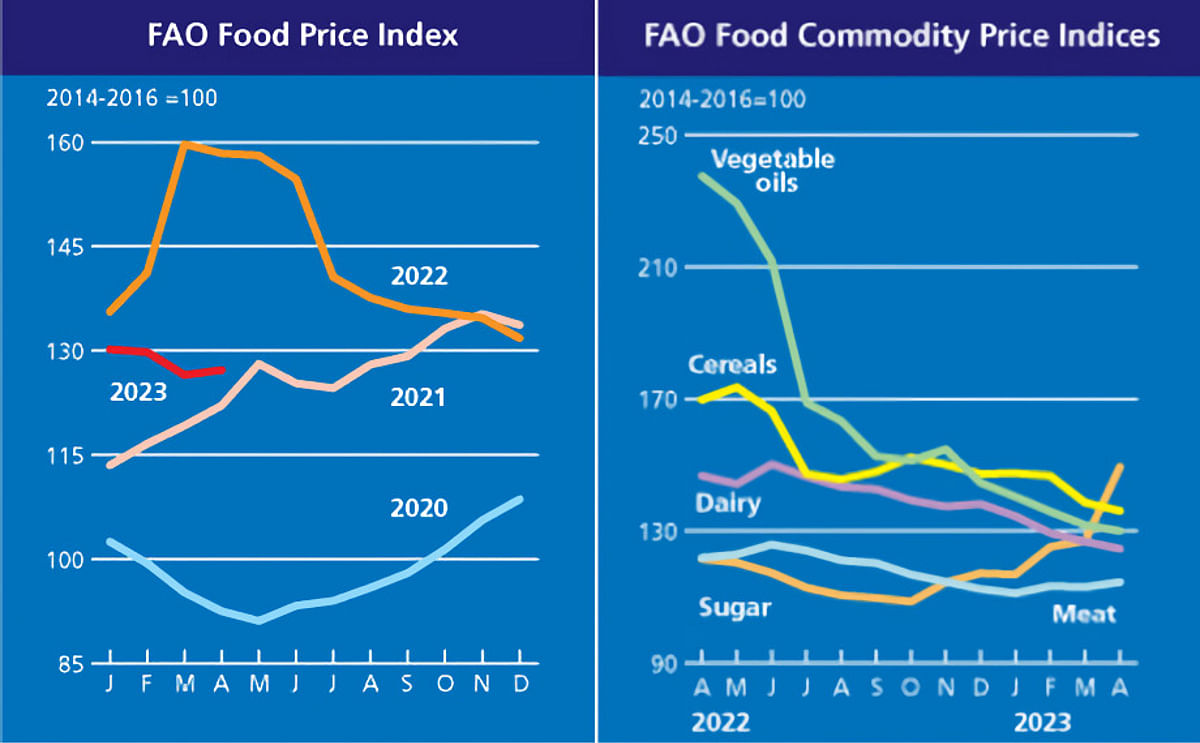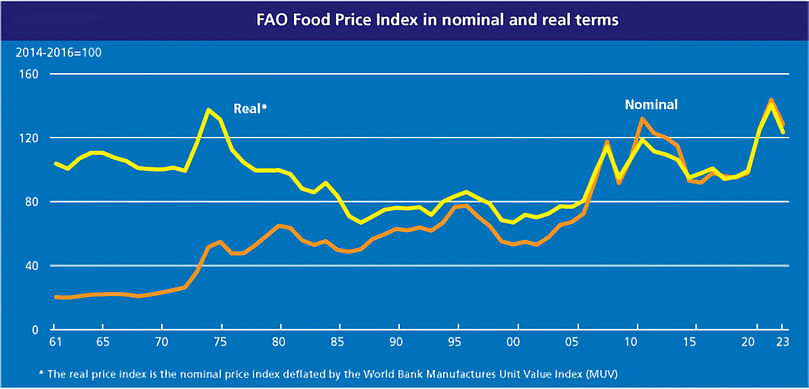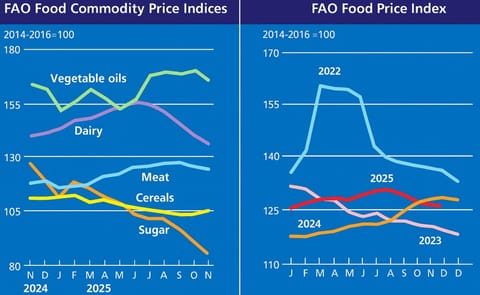The FAO Food Price Index rebounded slightly in April 2023
The FAO Food Price Index rebounded slightly in April 2023

The FAO Food Price Index* (FFPI) averaged 127.2 points in April 2023, up 0.8 points (0.6 percent) from March and standing 31.2 points (19.7 percent) below its value in the corresponding month last year. The slight rebound in the FFPI in April was led by a steep increase in the sugar price index, along with an upturn in the meat price index, while the cereals, dairy and vegetable oil price indices continued to drop.
The FAO Cereal Price Index averaged 136.1 points in April, down 2.4 points (1.7 percent) from March and as much as 33.5 points (19.8 percent) below its value one year ago. A decline in world prices of all major grains outweighed an increase in rice prices month-on-month. International wheat prices declined by 2.3 percent in April to their lowest level since July 2021, principally driven by large exportable availabilities in the Russian Federation and Australia.
Favourable crop conditions in Europe, along with an agreement at the end of April allowing Ukrainian grains to transit through the European Union countries that had imposed import restrictions on grain from Ukraine earlier in the month, also contributed to the overall softer tone in markets.
dWorld maize prices also fell, by 3.2 percent in April, mostly driven by higher seasonal supplies in South America as harvesting continued and favourable prospects point to a record output in Brazil. Among other coarse grains, world prices of barley and sorghum also declined, by 4.3 percent and 0.3 percent, respectively, reflecting weak global demand and spillover from weakness in international maize and wheat markets.
By contrast, sales to Asian buyers buoyed international rice prices during April. As a result, rice export quotations reversed most of the declines they registered in March 2023.
The FAO Vegetable Oil Price Index averaged 130.0 points in April, down 1.8 points (1.3 percent) from March, marking the fifth consecutive monthly decline. The continued decrease of the price index reflected the combined effect of stable world palm oil prices and lower soy, rapeseed and sunflower oil quotations.
Following a short-lived rebound in March, international palm oil prices remained virtually unchanged in April, as the downward pressure stemming from a lacklustre import demand from key importing countries was offset by support from comparatively limited supplies of leading producers.
By contrast, world soyoil prices continued to decrease, broadly weighed by the seasonal harvest pressure from a potentially record soybean crop in Brazil, despite sharply lower production prospects in Argentina. Meanwhile, international prices of rapeseed and sunflower oils also kept falling, chiefly underpinned by lingering abundant global exportable supplies.
The FAO Dairy Price Index averaged 124.6 points in April, down 2.2 points (1.7 percent) from March and 22.1 points (15.1 percent) from its level one year ago. In April, international prices of milk powders fell for the tenth consecutive month, primarily underpinned by the impact of the persistent slack global import demand.
Increased purchases by China and seasonally declining supplies from New Zealand prevented a potentially steeper fall in the world prices of whole milk powder, while increased current supplies from Western Europe exerted further downward pressure on skim milk powder prices.
Cheese prices also fell, principally reflecting high export availabilities in Western Europe, where more milk is being channelled into cheese production amid the seasonally rising milk output. By contrast, world butter prices remained largely stable, as increased supplies were generally adequate to meet increased import demand for near- and long-term deliveries.
The FAO Meat Price Index* averaged 114.5 points in April, up 1.5 points (1.3 percent) from March and standing 7.4 points (6.1 percent) below its value in the corresponding month last year. In April, international price quotations for pig meat rose the most on increased import purchases by Asian countries and the continued supply limitations in several leading exporters due to high production costs and animal health issues.
In the meantime, world poultry meat prices rebounded, following nine months of continuous declines, as import demand increased from Asia, while supply limitations arising from widespread avian influenza outbreaks continued in many regions.
International bovine meat prices also increased, in response to a decline in cattle supplies for slaughter, especially in the United States of America. Meanwhile, ovine meat prices remained largely stable, as elevated export availabilities from Oceania nearly matched increased imports by Asian and Middle Eastern countries.
The FAO Sugar Price Index averaged 149.4 points in April, up 22.4 points (17.6 percent) from March, marking the third consecutive monthly increase and reaching its highest level since October 2011.
The hike in prices was mostly related to heightened concerns over tighter global availabilities in the 2022/23 season after further downward revisions to the production forecasts for India and China, along with lower-than-earlier-expected outputs in Thailand and the European Union.
Despite the positive outlook for the 2023 sugarcane crops in Brazil, the slow start of the harvest due to above-average rains provided additional support to prices. Higher international crude oil prices and the strengthening of the Brazilian real against the United States dollar also contributed to the overall increase in world sugar prices.

The FAO Cereal Price Index averaged 136.1 points in April, down 2.4 points (1.7 percent) from March and as much as 33.5 points (19.8 percent) below its value one year ago. A decline in world prices of all major grains outweighed an increase in rice prices month-on-month. International wheat prices declined by 2.3 percent in April to their lowest level since July 2021, principally driven by large exportable availabilities in the Russian Federation and Australia.
Favourable crop conditions in Europe, along with an agreement at the end of April allowing Ukrainian grains to transit through the European Union countries that had imposed import restrictions on grain from Ukraine earlier in the month, also contributed to the overall softer tone in markets.
dWorld maize prices also fell, by 3.2 percent in April, mostly driven by higher seasonal supplies in South America as harvesting continued and favourable prospects point to a record output in Brazil. Among other coarse grains, world prices of barley and sorghum also declined, by 4.3 percent and 0.3 percent, respectively, reflecting weak global demand and spillover from weakness in international maize and wheat markets.
By contrast, sales to Asian buyers buoyed international rice prices during April. As a result, rice export quotations reversed most of the declines they registered in March 2023.
The FAO Vegetable Oil Price Index averaged 130.0 points in April, down 1.8 points (1.3 percent) from March, marking the fifth consecutive monthly decline. The continued decrease of the price index reflected the combined effect of stable world palm oil prices and lower soy, rapeseed and sunflower oil quotations.
Following a short-lived rebound in March, international palm oil prices remained virtually unchanged in April, as the downward pressure stemming from a lacklustre import demand from key importing countries was offset by support from comparatively limited supplies of leading producers.
By contrast, world soyoil prices continued to decrease, broadly weighed by the seasonal harvest pressure from a potentially record soybean crop in Brazil, despite sharply lower production prospects in Argentina. Meanwhile, international prices of rapeseed and sunflower oils also kept falling, chiefly underpinned by lingering abundant global exportable supplies.
The FAO Dairy Price Index averaged 124.6 points in April, down 2.2 points (1.7 percent) from March and 22.1 points (15.1 percent) from its level one year ago. In April, international prices of milk powders fell for the tenth consecutive month, primarily underpinned by the impact of the persistent slack global import demand.
Increased purchases by China and seasonally declining supplies from New Zealand prevented a potentially steeper fall in the world prices of whole milk powder, while increased current supplies from Western Europe exerted further downward pressure on skim milk powder prices.
Cheese prices also fell, principally reflecting high export availabilities in Western Europe, where more milk is being channelled into cheese production amid the seasonally rising milk output. By contrast, world butter prices remained largely stable, as increased supplies were generally adequate to meet increased import demand for near- and long-term deliveries.
The FAO Meat Price Index* averaged 114.5 points in April, up 1.5 points (1.3 percent) from March and standing 7.4 points (6.1 percent) below its value in the corresponding month last year. In April, international price quotations for pig meat rose the most on increased import purchases by Asian countries and the continued supply limitations in several leading exporters due to high production costs and animal health issues.
In the meantime, world poultry meat prices rebounded, following nine months of continuous declines, as import demand increased from Asia, while supply limitations arising from widespread avian influenza outbreaks continued in many regions.
International bovine meat prices also increased, in response to a decline in cattle supplies for slaughter, especially in the United States of America. Meanwhile, ovine meat prices remained largely stable, as elevated export availabilities from Oceania nearly matched increased imports by Asian and Middle Eastern countries.
The FAO Sugar Price Index averaged 149.4 points in April, up 22.4 points (17.6 percent) from March, marking the third consecutive monthly increase and reaching its highest level since October 2011.
The hike in prices was mostly related to heightened concerns over tighter global availabilities in the 2022/23 season after further downward revisions to the production forecasts for India and China, along with lower-than-earlier-expected outputs in Thailand and the European Union.
Despite the positive outlook for the 2023 sugarcane crops in Brazil, the slow start of the harvest due to above-average rains provided additional support to prices. Higher international crude oil prices and the strengthening of the Brazilian real against the United States dollar also contributed to the overall increase in world sugar prices.
* Unlike for other commodity groups, most prices utilized in the calculation of the FAO Meat Price Index are not available when the FAO Food Price Index is computed and published; therefore, the value of the Meat Price Index for the most recent months is derived from a mixture of projected and observed prices. This can, at times, require significant revisions in the final value of the FAO Meat Price Index which could in turn influence the value of the FAO Food Price Index.

The FAO Food Price Index rebounded slightly in April
Like to receive news like this by email? Join and Subscribe!
Get the latest potato industry news straight to your WhatsApp. Join the PotatoPro WhatsApp Community!
Uitgelichte Bedrijven
Sponsored Content
Sponsored Content
Sponsored Content
Sponsored Content









